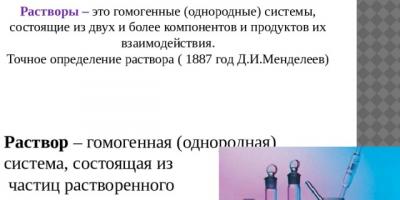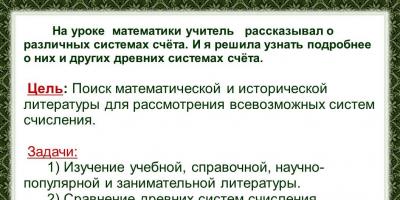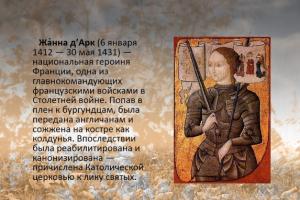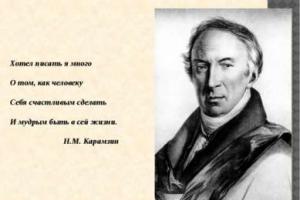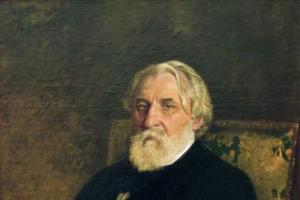Class: 6
Target:
- Develop the ability to analyze the activities of an outstanding person, work with a map, the text of a document, a picture.
- Call respect for the heroine of the French people and the desire to imitate her feat in the struggle for the independence of the Motherland.
- Expand students' knowledge of the history of medieval wars.
Lesson type: lesson on learning new material.
Lesson form: lesson characteristics.
Equipment:
- textbook by Agibalova E.V., Donskoy G.M. “History of the Middle Ages” p. 19 (p. 6-8) - Moscow, Education, 2006;
- assignments for groups<applications 1, 2, 3> , <Figures 1–15> and contour maps with atlas;
- educational painting “Joan of Arc’s entry into Orleans” – Paintings from the Middle Ages (D.I. Nikiforov, A.A. Svanidze, N.I. Zaporozhets);
- wall map “Europe in the XIV-XV centuries”;
- CD presentation “Jeanne d'Arc”<Appendix 4>;
- Memo on the characteristics of an outstanding figure<Appendix 5>.
During the classes
1. Introductory conversation, setting the lesson goal, explaining the work plan
Teacher's words: Each country has its own symbols, outstanding people who glorified the Motherland. In Russia it is Pushkin, Peter 1, Kutuzov, in England it is Nelson, Robin Hood, in France it is the Maid of Orleans<Appendix 4>. How many of you know who the Maid of Orleans is?
Students' responses are listened to.
Teacher's words: Joan of Arc was called the Maid of Orleans. Almost six centuries have passed since the day when Joan of Arc was burned in the Old Market Square in Rouen. She was only nineteen years old. Almost all her life - seventeen years - she was an unknown Jeannette from Domremy. Her neighbors would later say that she was just like everyone else. For one year she was the glorified Virgin Joan, savior of France. Her comrades would later say that she was an experienced military man. And for another year she was a prisoner of war and a defendant in the Inquisition Tribunal. Her judges will say: “Even a great scientist would have difficulty answering the questions that were asked of her.”
Today in class we will try to understand this story and give an objective description of Joan of Arc. There are reminders on your desks<Appendix 5> “Characteristics of a historical figure”, we will analyze the events of her life and make appropriate notes in the paragraphs of this memo. At home, using these notes, you will write an essay - a characterization of Joan of Arc. To make our work more efficient, we will divide you into four groups; after the story, the group teachers will perform the appropriate tasks, and after 3-4 minutes we will listen to the groups’ answers. Answers will be scored with stars. So, we have “historians”, “politicians”, “artists” and “cartographers” represented.
2. Personality formation of Zhanna d, Arc
Teacher's words: The first point of our research is the conditions for the formation of personality. You were given homework<Annex 1>, we will check it now. “Artists” will be the first to tell<pictures 1–4, see Appendix 6>what did Joan of Arc look like?
Answer from the group of “artists”: Zhanna looked like ordinary peasant girls: straight nose, big eyes, dark hair. In military armor, she looked determined and stern.
Teacher's words: how was Zhanna's childhood? “Historians” will answer.
Answer from the “historians”: Jeanne came from the peasant class. Her childhood was spent in the village, she did chores around the house, learned to spin, and knew how to do everything that a peasant girl needed. She could not read or write, she believed in God, and was very superstitious.
Teacher’s words: what was the situation in which Zhanna grew up, what was happening in the country<Figures 5–6, see Appendix 6>? “Politicians” and “artists” will tell.
Answer from “politicians” and “artists”: The Hundred Years’ War was going on between France and England. At the same time, there was a feudal war between the Duke of Burgundy and the Duke of Orleans. Squads of robbers terrified defenseless peasants and townspeople, took away their livestock, robbed and killed. During the war, armies plundered cities, took away all utensils, dishes, clothes, and food from people. After peace was concluded, the throne passed to the English king, who was less than a year old. The legal heir of the French king, the Dauphin Charles, who disagreed with this, fled from Paris. The British advanced to the south of the country, they besieged Orleans, its fall would have opened the way for them to the south. The French feudal lords were confused, and the people began a partisan struggle.
Teacher's words: now let the “cartographers” show on the map which territories were occupied by the British by 1429, where the most important battles took place, the city of Orleans.
“Cartographers” show on the map.
Summing up: so, Jeanne’s childhood passed in an atmosphere of war, robbery and violence, she did not receive an education (but we must not forget that at that time many noble people were illiterate), she was very religious, which also corresponds to that era. Make notes in your notes so that you can compile a description of the life of Joan of Arc.
3. Path of Glory
Teacher’s words: We move on to the next points of the memo “Purpose of activity”, “Character traits and abilities”.
The impressionable girl was convinced of her destiny and decided to lead the fight against her enemies. She left home, overcame a many-kilometer journey full of dangers and appeared before the Dauphin, the heir to the throne. She convinced him to give her an army and led a campaign against Orleans. She was greeted with joy by townspeople and peasants. With the arrival in Orleans, decisive actions against the British began. The siege of the city was lifted, and a turning point in the war came. With the participation of Joan, large areas of the country were liberated, and the Dauphin Charles was crowned and became King Charles VII.
Now each group is completing task No. 2<Appendix 2>, and in 3-4 minutes we will check who did how.
Group work with tasks.
Checking completed tasks.
Teacher’s words: a word to “historians”, what goal did Zhanna set for herself?
“Historians”: Jeanne wanted to save her homeland, she wanted the king to give her an army with which she would lift the siege of Orleans, and then accompany the king to Reims for the coronation.
The words of the teacher: and now the politicians will answer our question: why did the Dauphin decide to give the peasant woman an army?
“Politicians”: The Dauphin thought: “If she recognizes me as the legitimate son of the king and everyone believes her, then all of France will recognize me as the king!” It would be good to use it for your own purposes.”
The teacher’s words: and now the “cartographers” will show Joan’s path from her native village of Domremy to Chinon Castle, the campaigns of the army led by Joan of Arc.
“Cartographers” work with a map, showing Domremy, Chinon, Orleans, Troyes, Reims, Blois.
Teacher’s words: it’s the turn of the “artists”<Figures 7–11, see Appendix 6>, describe the painting “The Entry of Joan of Arc into Orleans”.
“Artists”: the people greeted Jeanne with delight and faith in deliverance. There were knights in her army, she herself rode in front on a white horse, dressed in knightly armor, with a royal banner in her hands.
Teacher's words: how did she behave during the storming of the fortress?
“Artists”: During the storming of the fortress, Jeanne showed perseverance, intelligence, modesty, willpower, prudence, courage, and perseverance.
The words of the teacher: the word to “politicians”, they will answer the question, why was the coronation necessary?
“Politicians”: Until the Dauphin performed the coronation ceremony, he was not considered a king, and the British had reason to imagine the French fighting the invaders as “rebels” against the “legitimate authority.” The coronation in Reims meant a rejection of the terms of the treaty in Troyes: submission to the English crown. This was tantamount to declaring the independence of France.
Teacher's words: now let's see why the French began to win victories? What character traits did Jeanne display during this campaign? “Historians” answer.
“Historians”: The French believed in their strength, they felt themselves to be part of a single whole - France. The war ceased to be a matter of one class, because everyone suffered under the yoke of the British. More and more fighters flocked to the banner of Jeanne, and the struggle became popular. Jeanne was selfless, she did not want anything for herself personally, but asked the king to exempt the inhabitants of her native village from taxes. This speaks of her modesty and generosity.
Teacher's words: please tell me, what abilities and skills do you need to have to achieve such results?
Students' answer: you must have organizational skills, the ability to persuade, and to lead.
Summarizing.
The teacher’s words: so, we see that Jeanne set a goal - to save her homeland, led an army and lifted the siege of Orleans, and achieved the coronation of Charles. At the same time, she showed herself to be courageous, convinced, persistent and purposeful, persistent and decisive. She had good organizational skills and the ability to convince people. Make notes in your memos.
4. Captivity, execution and glory after death
Teacher's words: Soon the king began to feel burdened by Jeanne's presence and became distrustful. Jeanne tried to take Paris, but was wounded, the French retreated. She was captured near the city of Compiegne by the Burgundians, who sold her to the British. The king did not ransom Jeanne from captivity; she appeared before the Inquisition, was accused and burned at the stake in the city of Rouen in 1431. A quarter of a century later, the King of France ordered a review of the court case, and Jeanne was acquitted, and in the 20th century she was canonized.
Let's see what personality traits Zhanna showed? What are the results of its activities?
Groups will complete task No. 3<Appendix 3 > <Figures 12–15, see Appendix 6>, after a while we will start checking it.
Work in groups.
Teacher's words: So, the “cartographers” will show us Jeanne’s last campaign, the city of Compiegne, near which Jeanne was captured, the city of Rouen, in which the Virgin was executed.
“Cartographers” work with a map.
The teacher’s words: and now the “artists” will show in what order the pictures should go, which fragments of the text correspond to them.
“Artists”: fragment of text A corresponds to picture No. 3<Figure 12, see Appendix 6>, text B – picture No. 1<Figure 13, see Appendix 6>, text B – picture No. 2<Figure 14, see Appendix 6>, text G – picture No. 4<Figure 15, see Appendix 6>.
Teacher's words: Let's see how Zhanna behaved during the trial. A word for “historians”.
“Historians”: She answered the most difficult questions very carefully. Her answers showed her intelligence, prudence, courage, and justice. She did not shed blood in vain. She sincerely loved her homeland. She showed no greater interest in her fame and was modest.
Teacher's words: why did the king betray Jeanne? “Politicians” will answer.
“Politicians”: the memory of the Jacquerie peasant uprising was still alive. “Who knows,” thought the feudal lords, “whether Jeanne might turn into a new Jacques?” The royal advisers were concerned about Jeanne's influence on the Dauphin, and the love and respect of ordinary people for her. The all-powerful feudal lords were afraid that the Dauphin would cease to be a toy in their hands, but most of all they were afraid of the uprising of the people.
The teacher’s words: why did the king decide to acquit the maiden years later?
“Politicians”: he decided to refute the accusation that was still weighing on him that he received the crown from the hands of a witch.
Teacher's words: let's summarize. How did the Hundred Years' War end? The “cartographers” will tell us and show us.
“Cartographers”: show on the map the territories remaining in the hands of the British under the treaty of 1453.
Teacher’s words: so, what are the results of Zhanna’s activities?
Student answers: with her struggle, Zhanna brought the liberation of the Motherland closer.
Teacher's words: let's add character traits and performance results to the description.
5. Vital assessment
Teacher's words: How can you evaluate the life of Joan of Arc: was she a “messenger of God” or a sorceress? Was she an ordinary peasant woman or a talented military leader? Who was she?
Students' responses are listened to.
Teacher's words: Joan of Arc was an excellent organizer and talented leader. The liberation of Orleans and the subsequent coronation of the Dauphin in Reims dealt a strong blow to the rumors then circulating about Charles’s illegitimacy and dispelled doubts about his right to the throne. Everything she did, she herself attributed to voices, but despite this, Zhanna must be regarded as a normal, sensible woman. In military affairs, she was a realist: she understood artillery and paid tribute to its capabilities. Jeanne had to deal with people of all classes - from workers to kings; At the same time, she did not experience any embarrassment, behaved completely naturally, and got what she wanted from them. She knew how to persuade, she knew how to force. As befits a respectable peasant woman, she was aware of the full importance of maintaining decency and did not tolerate foul language and neglect of religious rites.
6. Homework
Using the memo, write an essay describing Joan of Arc. Don't forget to determine your attitude towards our heroine.
7. Lesson grades
References:
- Donskoy G.M. Moral education in teaching the history of the Middle Ages in the 6th grade. – Enlightenment, 1988.
- Donskoy. G.M. Assignments for independent work on the history of the Middle Ages. – Education, 1987.
- Kryuchkova E.A. Workbook on the history of the Middle Ages. – Enlightenment, 2002.
- A book to read on the history of the Middle Ages. Edited by N.I. Zaporozhets, A.A. Svanidze. – Enlightenment, 1986.
- Raitses V.I. Joan of Arc. Facts, legends, hypotheses. Leningrad "Science" 1982.
- Stepanova V.E., Shevelenko A.Ya. History of the Middle Ages. Reader. Parts 1-2. – Moscow, Education, 1988.
To use presentation previews, create a Google account and log in to it: https://accounts.google.com
Slide captions:
Joan of Arc
We know more about Joan of Arc than about any other of her contemporaries, and at the same time it is difficult to find another person among the people of the 15th century whose image would seem so mysterious to posterity.
Jeanne was born on January 6, 1412 in the village of Domremy at the headwaters of the Maat River, into a peasant family. At the height of civil strife and the Hundred Years' War, a 17-year-old girl named Jeanne appeared to the dethroned Dauphin Charles and said that the “voices of heaven” commanded her to free France from her enemies. The Dauphin believed in Jeanne's connection with the angels and placed troops under her command. The story of the liberation of France by the Maid of Orleans and her installation of the rightful heir to the throne is very similar to the legend.
Zhanna appeared at the right time and in the right place. The Hundred Years' War was raging. King Charles VI of France lost his mind in 1392 and lost his crown to the British. This caused a power struggle between England and France. Karl was ready to use any method to achieve power, including the wonderful gift of Joan of Arc. At the age of 17, Jeanne arrived to the king’s representative in the town of Vaucouleurs and declared that God had called her to liberate France.
After much hesitation, the official gave Jeanne a horse and an escort. On February 22, 1429, she appeared at the castle of Chinon to meet with Charles. To test Jeanne's unusual gift, the Dauphin exchanged clothes with his entourage. The guest had never seen the heir before, but immediately went to him. This made a strong impression on Charles and his court. As a result of a brilliant military operation, Jeanne liberated Orleans. Then her troops recaptured Jargeau, Mena, Beaugency and ensured the coronation of the Dauphin Charles in Reims on July 17.
During an operation near the city of Compiegne on May 23, 1430, Jeanne was captured by the Burgundians. They said this happened because she did not have a magic sword with her on this outing. She was imprisoned in Beaulieu Castle. Charles VII achieved his goal - he became king, and he no longer needed Jeanne's help. He refused to pay the ransom for her. The Burgundians handed Joan over to the British. On January 9, 1431, in the city of Rouen, Bishop Pierre Cauchon, adviser to the English king Henry VI, accused Jeanne of witchcraft, and she was soon burned.
It is not known exactly who was executed in Rouen. On January 30, a woman was taken to the market square, her face covered with a cap. The soldiers were ordered not to let anyone say a word to the criminal. The woman was tied to a post, covered with brushwood and a fire was lit. When only a pile of ashes remained at the execution site, one English soldier said: “We died, we burned a saint.”
The ashes of the Maid of Orleans were scattered over the Seine. However, nothing proves that Joan of Arc died. Why did the executioners cover her head? Were you afraid that someone would recognize her by sight or voice?
There is another description of the execution of Jeanne. Black smoke, pierced by red tongues of flame, rose in thick clouds and hid her from view; from behind this curtain her voice was heard, loudly and with inspiration reading prayers; when at times the wind blew the smoke to the side, one could see a face turned to the sky and moving lips. Finally, the merciful flame quickly shot up, and this face was hidden forever, this voice was forever silent.
5 years after the execution in Rouen, a woman appeared in Lorraine who called herself Jeanne. She found the brothers of the Maid of Orleans, and they recognized her as their late sister! Her comrades, seeing her, fell to their knees. The Countess of Luxembourg and the Count of Warenburg announced that they would be Jeanne's friends. Was it really that easy to deceive these people? Or was it really Jeanne?
Centuries have passed since then. The image of an extraordinary girl - a bright meteor flying across the sky of France to fade away in the smoke of a fire - recedes further and further into the depths of the past. And for us, her image becomes more and more mysterious, exciting and wonderful.
Slide 1
Presentation on the topic: “Joan of Arc.”
6a grade students of Secondary School No. 331 Sefieva Leila.
Slide 2

Joan of Arc (January 6, 1412 - May 30, 1431) - national heroine of France, one of the commanders-in-chief of the French troops in the Hundred Years' War. Captured by the Burgundians, she was handed over to the British and burned at the stake as a witch. She was subsequently rehabilitated and canonized - canonized by the Catholic Church.
Slide 3

Biography.
Joan of Arc was born in the village of Domremy in the family of wealthy peasants Jacques d'Arc and Isabella Romeu.
House of Joan of Arc in Domremy. Nowadays it is a museum.
Slide 4

At the age of 13, Jeanne first heard the voices of the Archangel Michael, Saint Catherine of Alexandria and Margaret of Antioch, who sometimes appeared to her in visible form. After some time, they allegedly revealed to Jeanne that it was she who was destined to lift the siege of Orleans, elevate the Dauphin to the throne and expel the invaders from the kingdom.
Michael the Archangel.
Catherine of Alexandria.
Margaret of Antioch.
Slide 5

Vision of Joan of Arc by Jules Bastien-Lepage (1879).
Slide 6

When Jeanne turned 17, she went to the captain of the city of Vaucouleurs, Robert de Baudricourt, and announced her mission. Having been ridiculed, Zhanna was forced to return to the village, but a year later she repeated her attempt. This time, the captain, amazed by her persistence, agreed to give her people so that she could go to the king, and also provided her with men's clothing.
John Everett Millais. "Joan of Arc".
Slide 7

In 11 days, on March 4, 1429, Jeanne arrived at the residence of the Dauphin Charles. She announced to Charles that she had been sent by Heaven to liberate the country from English rule and asked for troops to lift the siege of Orleans. Karl hesitated. He ordered her to be sent to Poitiers, where she was to be interrogated by theologians. After nothing was found that could cast a shadow on the girl’s reputation, Charles decided to transfer command of the troops into her hands and appointed her commander-in-chief.
Charles VII the Victor.
Slide 8

Zhanna is a military leader.
After her appointment, armor, a banner and a banner are made for Jeanne. Then she headed to Blois and, at the head of the army, set out for Orleans. On April 29, Jeanne and a small detachment entered Orleans. On May 4, her army won its first victory. Victories followed one after another, and already on the night of May 7-8, the British were forced to lift the siege of the city. After the victory at Orleans, Jeanne was nicknamed the “Maid of Orleans.”
Joan of Arc at the siege of Orleans.
Slide 9

Charles's hesitation was the reason that Jeanne set out on her next campaign to the Loire castles occupied by the British on June 9. On June 11, the army approached the central fortified point of the British on the Loire - Jargeau, the next day Jargeau was taken by storm. On June 15, Jeanne performed on Meun-sur-Loire, on June 16 - on Beaugency, and on June 18, the decisive battle of Pat took place with the English army, which ended in the complete defeat of the British.
Battle of Pata.
Slide 10

Joan went to the king and urged him to go to Reims, the traditional place of coronation of French kings, for confirmation. On June 29, the campaign towards Reims began. On July 17, the king was solemnly anointed in the Reims Cathedral in the presence of Joan of Arc.
Joan of Arc at the coronation of Charles VII.
Slide 11

After the coronation, Jeanne urged Charles to launch an attack on Paris, but Charles again began to hesitate. The attack on the capital was launched only in September, but the offensive was quickly stopped. In the spring of 1430, hostilities were resumed. On May 23, as a result of betrayal, Joan of Arc was captured by the Burgundians. King Charles did nothing to save Joan. Soon the Burgundians sold it to the British. In 1430, Jeanne was transported to Rouen.
The tower in Rouen where Jeanne was imprisoned.
Slide 12

Trial and conviction.
The trial began on February 21, 1431. Despite the fact that Joan was tried by the church on charges of heresy, she was kept in prison under the guard of the British as a prisoner of war. The process was led by Bishop Pierre Cauchon. The English government did not at all hide its involvement in the trial of Joan of Arc. During the trial, it became clear that it would not be so easy to accuse Jeanne - the girl stood at the trial with amazing courage and confidently refuted accusations of heresy and relations with the devil, avoiding numerous traps.
Interrogation of Joan of Arc.
Slide 13

On May 24, Cauchon resorted to outright meanness - he presented the prisoner with a ready-made bonfire for her execution by burning and already near the bonfire he promised to transfer her from an English prison to a church prison if she signed a paper renouncing heresies and obedience to the Church. At the same time, the paper with the text was replaced by another, on which there was a text about the complete renunciation of all one’s “delusions.” It was on this paper that Zhanna gave up. Naturally, Cauchon did not even think of fulfilling his promise and sent her back to her previous prison. A few days later, the tribunal sentenced her to death.
Joan of Arc in prison. Howard Pyle.
Joan of Arc is the most prominent figure in the entire history of the Hundred Years' War (which took place in the 14th and 15th centuries between England and France). Despite the large number of publications about this intelligent and courageous person, there are many inconsistencies in her biography. But be that as it may, it was under her command that the French won several victories and, in the end, drove the British out of their territory.
Childhood
Zhanna was born in the village of Domremy into a family of wealthy peasants; besides her, the family also had four children. Zhanneta was no different from her peers, she grew up as a cheerful, kind and sympathetic girl, willingly helped around the house, herded cattle, and knew how to sew and spin flax. She didn't go to school and I couldn’t read or write. Since childhood I have been very pious As soon as she heard the bell ringing, she knelt down and began to pray.
Putting on a man's dress, the 16-year-old girl hit the road. Upon arrival at the place, the king gave Jeanne a test and after the young peasant woman passed it, she was assigned a military detachment.
Jeanne at war
Joan of Arc was not an experienced military leader, but natural intelligence and observation helped her defeat the enemy near Orleans. The message about the lifting of the siege on the city inspired the French, and they won several more victories and liberated the southwest of the country from the British.
A year later, the French under the command of Jeanne won a victory at Poitiers. This cleared the way, and the Dauphin and his army were able to enter Reims. On July 17, 1429, the coronation of Charles VII took place, Jeanne was next to him all this time.
In September 1429, the French attempted to liberate Paris but failed. During the battle, Joan was wounded, and the king ordered his army to retreat.
Zhanna remained with a small detachment and nevertheless entered the city.
Captivity and execution of Saint Joan
The popularity of the Maid of Orleans among the peasants grew every day, which greatly frightened Charles VII and his entourage.
On May 23, 1430, betrayed by her compatriots, she was captured by the Burgundians. Zhanna tried to escape twice, the second attempt almost cost her life: she jumped out of the window. Later in court she will be accused of attempted suicide. The king did nothing to free the girl, although according to the customs of the Middle Ages he could ransom her.
Then The Burgundians sold Joan to the British for 10 thousand livres, who handed it over to the clergy.
The trial, led by Pierre Cauchon, began on February 21, 1431 and lasted more than three months. They tried to accuse Jeanne of heresy and connection with the devil. By proving her guilt, the British could prove that Charles VII was ruling France illegally. But it was not easy to blame an illiterate commoner. The court was never able to obtain a confession of heresy from her.
Trying to break her will, her captives were kept in inhumane conditions and intimidated with torture, but she did not admit her guilt. Then she was accused of something that did not require proof - wearing men's clothing.
Cauchon knew that if he sentenced the girl to death without proof of her guilt, he would create the crown of a great martyr around her. Therefore, he resorted to meanness: they built a fire in the square and near it the bishop announced: if Jeanne signed a paper renouncing heresy, she would be pardoned and placed in a church prison, where conditions of detention would be better.
However, the illiterate peasant woman was given another paper, in which it was written that she completely renounced her errors.
Zhanna was deceived and again returned to prison for prisoners of war. Here they took away her women's clothes by force, and the girl had to put on a man's dress. This meant that Jeanne had committed the crime again, and the court sentenced her to be burned at the stake.
On May 30, 1431, the 19-year-old French heroine was executed in Rouen on the Old Market Square, and her ashes were scattered over the Seine.

By order of Charles VII, a quarter of a century after the execution of Saint Joan, another trial took place. 115 witnesses were interviewed who knew Joan of Arc during her lifetime. All charges were dropped from her and her feat was recognized.
In 1920, after almost 5 centuries, The Catholic Church canonized the Virgin of Orleans.
If this message was useful to you, I would be glad to see you
Or rather, she will become a legend 17 years later. In the meantime, the newborn was named Zhanna.
“The feat played a big role in the rise of the struggle of the French people against the English invaders Joan of Arc. The deep faith of a simple peasant girl in victory raised the morale of the troops” - a passage familiar to everyone from a school history textbook. There is a lot of citizenship in it, but very little truth.
“Since childhood, angels and saints appeared to her and guided her on the true path. She was a psychic of the highest order and had influence on the powers that be” - an alternative version in which there is a lot of mysticism, but even less truth.
The Vision of Joan of Arc (Jules Bastien-Lepage, 1879). Photo: Commons.wikimedia.org
Give me a miracle!
For some mysterious reasons, the most interesting and exciting version, which was voiced a long time ago by none other than Cardinal Mazarin, known to us from the Musketeer novel Alexandra Dumas"Twenty Years Later" This is how the foremost political strategist of his time talked about Jeanne: “The whole story with the Virgin of Orleans was just a political trick invented by the courtiers Charles VII. And, believing that all this was done in the name of religion and at the behest of a miracle, the entire people of France rushed there like to a fire, or rather, like a herd of sheep.” In other words, a huge PR project took place.

Joan of Arc at the siege of Orleans. S. Lenepvö. Photo: Commons.wikimedia.org
Imagine: almost half of France was captured by the British and Burgundians. The legitimacy of the French heir to the throne is highly questionable - it is known that his father, King Charles VI, spoke of him as follows: “This so-called son of mine.” Formally, the nine-month-old king of England and France is considered Henry VI of England. Orleans is under siege. If the fortress falls, France will fall, the heir will be sent to a monastery, and his nobles will be deprived of their lands, rights and privileges. Only a miracle could save France.
“If God did not exist, he would have to be invented” - Voltaire would utter the famous phrase only 350 years later. “You shouldn’t wait for a miracle - you need to do it yourself,” his compatriots decided. There is an opinion that one of the “fathers” of the phenomenon called Jeanne the Virgin was a relative of the heir to the throne, a politician, military man and alchemist Gilles de Rais. The scheme was simple. To begin with, they started a rumor about certain prophecies. According to them, the country that was destroyed by a woman, Isabella of Bavaria, will be reconquered by a woman. Allegedly, an immaculate maiden (in the sense of a virgin) will rise from the Lorraine lands, who will save Orleans, and the kingdom will be returned to its true sovereign, Charles VII.
And in order for the prophecies to be fulfilled properly, the main figure, the virgin itself, had to be found and prepared. There were no problems with “finding” - due to a congenital defect, Zhanna was a Virgin with a capital V. The unfortunate young lady suffered from Morris syndrome. It looks like a female, but the ovaries and uterus are completely absent, but there are male testes, similar to inguinal hernias, which was documented during the examination of Zhanna in captivity. The vagina is so narrow that the Burgundian soldiers who tried to rape her suffered a shameful failure in every sense.
Hashish and crown?
The preparation was also excellent. The technology of the “voices of saints and angels” that Jeanne allegedly heard was known to any alchemist since the Crusades in Palestine. A heavy dose of hashish mixed with honey allowed Islamic assassins to see and hear a whole brood of paradise houris. Claim that this is exactly how Zhanna spoke to Archangel Michael And Saint Catherine And Margarita, probably not. But everything is shaping up very similar. For the time being, these voices visit Zhanna regularly. The funny thing is: the mysterious “messengers of heaven” tell only what Charles VII personally needs. What’s even funnier is that after a certain point, the “voices” visiting Zhanna begin to spew nonsense and give extremely contradictory, or even downright stupid, advice, because of which she, in fact, ends up captured and burned at the stake.

Joan of Arc at the coronation of Charles VII. Jean Auguste Dominique Ingres, 1854. Photo: Commons.wikimedia.org
This “moment of truth” was the interval between the presentation of Joan to the court and the coronation of Charles VII in Reims. Everything resembles a perfectly choreographed performance. Act one. Jeanne arrives to the heir to the throne. She demands that Charles bring her his kingdom as a gift. Usually such impudence results in either a straitjacket or a rack. But no. Karl is only “slightly surprised” and orders the court notary to draw up a corresponding act. For three minutes, Jeanne is formally the Queen of France, after which she solemnly presents the crown to the “king of heaven.” And only then gives it to Karl. From now on, he seems to be “crowned by Heaven through the mediation of a holy virgin.” Act two. Seven thousand of the finest troops march with Jeanne to Orleans. Commands the "parade" Gilles de Rais. In just two weeks, the blockade of the city is lifted almost bloodlessly - even the British are afraid of the “will of Heaven.” Act three. This is how the chronicle says about him: “On the way to Reims, where Charles was to be crowned, the most important cities surrendered without a fight, because Joan’s glory ran ahead.” A celebration of PR.
But Zhanna was no longer needed and was even becoming dangerous. She had to one way or another leave the political scene and life in general. The University of Paris put the blame on the French king - it was its lawyers who conducted the process in such a way that Jeanne turned out to be either a witch or a heretic, from whom it was somehow awkward to accept the crown. Karl was forced to start the rehabilitation process. The Pope went to meet him halfway. Jeanne was posthumously acquitted, and almost 500 years later she was canonized. And everything would be fine, but here’s what the Roman high priest himself, who acquitted her, wrote about “Jeanne’s feat”: “Was this the work of divine or human hands? It’s difficult for me to decide this...”


